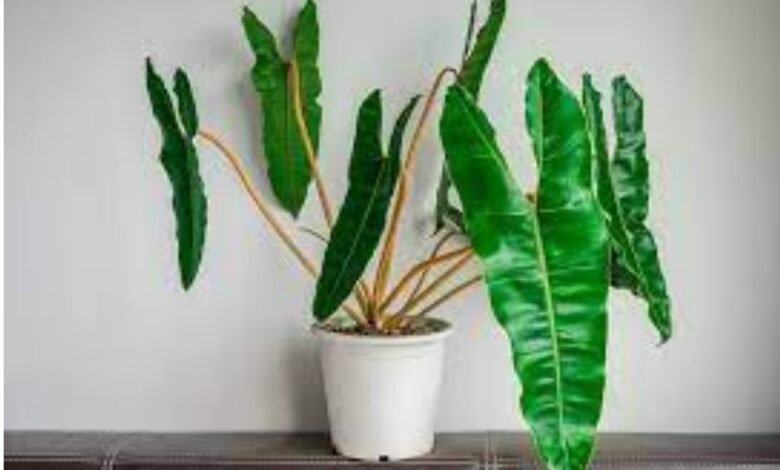Philodendron billietiae – Growing Conditions, Propagation, and Common Problems

Philodendron billietiae is a plant that has attracted the public’s attention and is quickly becoming popular among plant lovers. Its large, heart-shaped leaves and vivid, bright orange petioles make it a lovely indoor plant.
In this blog post, you will learn all you want to know about how to grow and care for Philodendron billietiae.
What is Philodendron billietiae?
Philodendron Billietiae is a tropical plant species found in Brazil, French Guiana, and the Guyana Region. It lifeis classified under the Araceae family. This species of Philodendron is prized for its elongated and slim leaves, which are not less than three feet long. It boasts showy orange petioles, which contribute to the aesthetic appeal of the plant when placed in any room.
Growing Conditions of the Philodendron billietiae
Philodendron billietiae can get quite large leaves, and their foliage can be massive when the plant grows. However, it can be a showpiece indoors. Here is a go-through of the conditions and environmental parameters that it loves:
Ideal Growing Conditions
The Philodendron billietiae grows in warm ambient temperatures with high moisture to give the plant a natural growth environment.
Light Requirements
This plant is best grown in bright, indirect sunlight. Although it can be grown under low light conditions, growth will be much slower, and the leaves will not be as large as when grown under optimum conditions. Do not expose it directly to the sun, as this will burn the leaves.
Temperature and Humidity
Philodendron billietiae grows best in a temperature range of 65 °F (18C °C). One has to be very careful with the temperature, which is tolerable for the plant, and any quick temperature change can become a stress for the plant. High humidity is preferred, and it is recommended to be between 60% and 80%.
For instance, if you reside in a desert, you can use a humidifier or place a tray of water near the plant so that humidity can be enacted.
Read also: Why Does Everyone Have a White Fox Hoodie?
Propagation of the Philodendron Billietiae
Propagation of Philodendron billietiae is relatively easy; the plant can be propagated through stem cuttings. Here’s a step-by-step guide:
Select a Healthy Stem: Select a stem with as many nodes as possible; these are the points from which leaves grow.
Cut the Stem: Plant cuttings should be made with a clean, sharp knife or pair of scissors. Prepare each cut just below a node.
Prepare the Cutting: Cut off the outer leaves until only one or two remain at the top of the stalks.
Root the Cutting: Put the cutting in a water or potting mix container. If using water, replace it every few days to make the water fresh for the herbs.
Transplant: After roots have formed, transfer the cutting to a potting medium with good drainage.
Propagation should be done in the spring or summer since the plant is growing, especially during this season. It takes a few weeks before a plant displays root formation.
Common Problems of Philodendron Billietiae
Like all Philodendron species, Philodendron billietiae plants can be affected by some problems. Here’s how to address the most common issues: Here’s how to address the most common issues:
1. Yellowing Leaves
In this case, yellow leaves indicate excessive water being supplied to the plants or low-quality soil. Feel the soil and make sure the pot has a good drainage system, if it has one. If the problem continues, consider changing the soil on the plant by using another pot.
2. Pests
Like most houseplants, Philodendron billietiae has some insect pests, including spider mites, aphids, and mealy bugs. Another is to check the leaves for any indication of pests—for instance, webs or sticky materials—and control infestations with insecticide soap or neem oil.
3. Root Rot
This disease is often attributed to overwatering your plant, or the soil you use being poor in drainage. If you smell a foul odor or the roots look like a mass of mush, it probably is root rot.
Transplant, cut off the roots, remove the plant from the pot, and then report it in a new pot.
Is Philodendron billietiae Toxic?
Yes, Philodendron billietiae is toxic when ingested by human beings or pets that may come across it. It is reported to contain calcium oxalates that irritate the mucous membrane lining of the mouth and throat, forming swellings.
This way, the plant should be placed away from children and pets since they tend to nibble on anything they find.
Conclusion
Philodendron billietiae is yet another beautiful addition to any indoor plant enthusiast’s home and garden. It gives a feel of the tropics. If well taken care of, it can grow to gigantic proportions and become a focal point in your wooden house.
For those with prior experience or those just starting, the Philodendron Billietiae will provide hours of enjoyment while boasting about your ability to care for the plant.






